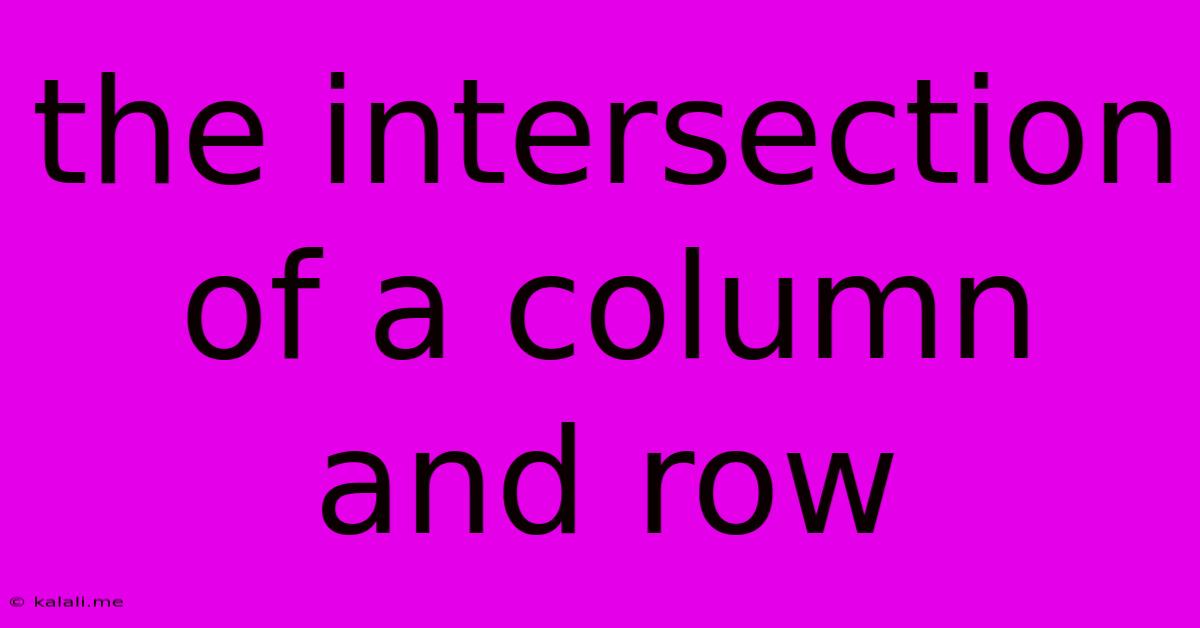The Intersection Of A Column And Row
Kalali
Jun 12, 2025 · 3 min read

Table of Contents
The Intersection of a Column and Row: Understanding Cells and Their Importance
The seemingly simple intersection of a column and a row is fundamental to how we organize and interpret data. This intersection, forming what we call a cell, is the building block of spreadsheets, databases, and many other data structures. Understanding this intersection and its implications is crucial for anyone working with data, from casual spreadsheet users to data scientists. This article delves into the significance of this intersection, exploring its applications and importance across various fields.
What is a Cell?
A cell, at its most basic, is the point where a single column and a single row meet. Imagine a grid; the columns run vertically, and the rows run horizontally. Each individual square within that grid is a cell. This seemingly simple concept underpins the organization of vast quantities of information. Within a cell, we can store various types of data, including:
- Numbers: Numerical data, vital for calculations and analysis.
- Text: Alphanumeric characters forming labels, descriptions, or other textual information.
- Dates: Specific dates and times, useful for tracking events and scheduling.
- Formulas: Instructions that perform calculations based on data in other cells.
- Functions: Pre-built formulas that automate complex calculations.
The ability to store different data types within a single cell makes this intersection incredibly versatile.
The Importance of Cell References
The location of each cell is crucial, as it's referenced using a unique coordinate system (e.g., A1, B2, C3). This addressing system allows formulas and functions to precisely identify the data they need to process. For instance, a formula in cell D1 might add the values in cells A1 and B1. This referencing system is essential for data manipulation and analysis.
Applications Across Diverse Fields:
The intersection of a column and a row, and the resulting cell, finds applications in numerous areas:
- Spreadsheets (Excel, Google Sheets): The most common application, enabling the creation of budgets, reports, and data visualizations.
- Databases (SQL, MySQL): Data is organized into tables with rows representing records and columns representing attributes. Each intersection forms a data point within the database.
- Data Analysis & Visualization: Tools like Tableau and Power BI rely on this fundamental structure to process and display information effectively.
- Programming: Arrays and matrices in programming are essentially two-dimensional data structures analogous to spreadsheets, where each element is accessed through its row and column index.
- Project Management: Gantt charts and project planning tools often use a grid-like system to track tasks and timelines, with cells representing specific tasks and their durations.
Beyond Simple Data Entry: The Power of the Intersection
The intersection isn't merely about storing data; it's about creating relationships and enabling complex operations. By referencing cells within formulas, we can perform calculations, automate processes, and extract meaningful insights from the data. This ability to link and interrelate data points makes this seemingly simple intersection a powerful tool for data management and analysis.
Conclusion:
The intersection of a column and a row, resulting in the creation of a cell, is a foundational concept in data management. Its simplicity belies its power and versatility, forming the basis for numerous applications across various fields. Understanding how cells work, how they are referenced, and their implications is key to effectively utilizing data for analysis, reporting, and decision-making.
Latest Posts
Latest Posts
-
Which Of The Following Is A Component Of Effective Education
Jun 13, 2025
-
Diagram Of 2 Stroke Diesel Engine
Jun 13, 2025
-
The First Psychology Laboratory Was Founded By
Jun 13, 2025
-
How Many Players Are In A Basketball Game
Jun 13, 2025
-
Which Of The Following Is An Example Of Oxidation
Jun 13, 2025
Related Post
Thank you for visiting our website which covers about The Intersection Of A Column And Row . We hope the information provided has been useful to you. Feel free to contact us if you have any questions or need further assistance. See you next time and don't miss to bookmark.